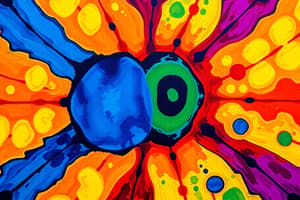Podcast
Questions and Answers
What is the smallest unit of matter in the hierarchy of life?
What is the smallest unit of matter in the hierarchy of life?
- Subatomic particles
- Molecules
- Atoms (correct)
- Cells
How many daughter cells will be affected if nondisjunction occurs during Meiosis I?
How many daughter cells will be affected if nondisjunction occurs during Meiosis I?
- 2 (correct)
- None
- 1
- 4
Which feature of the plasma membrane is not likely to increase fluidity?
Which feature of the plasma membrane is not likely to increase fluidity?
- Short acyl tails (correct)
- Presence of single bonds
- Presence of double bonds
- Presence of cholesterol
What are the two ends of a DNA strand?
What are the two ends of a DNA strand?
Which organelle is responsible for cellular respiration?
Which organelle is responsible for cellular respiration?
Flashcards
Atom
Atom
The smallest unit of matter that retains the chemical properties of an element.
Nondisjunction in Meiosis I
Nondisjunction in Meiosis I
Cell division where homologous chromosomes fail to separate properly, resulting in daughter cells with an abnormal number of chromosomes.
Short acyl tails
Short acyl tails
The shorter fatty acid tails of phospholipids make the membrane more rigid.
5' and 3' ends of DNA
5' and 3' ends of DNA
Signup and view all the flashcards
Mitochondria
Mitochondria
Signup and view all the flashcards
Study Notes
Hierarchy of Life
- The smallest unit of matter in the hierarchy of life is the atom.
Meiosis
- If nondisjunction occurs during Meiosis I, all four daughter cells will be affected.
Plasma Membrane
- The feature of the plasma membrane that is not likely to increase fluidity is cholesterol.
DNA Structure
- The two ends of a DNA strand are the 5' (five prime) end and the 3' (three prime) end.
Cellular Organelles
- The organelle responsible for cellular respiration is the mitochondria.
Studying That Suits You
Use AI to generate personalized quizzes and flashcards to suit your learning preferences.
Description
Test your knowledge of introductory cell and molecular biology with this practice final exam from Tulane University. The 50 questions cover key concepts and topics, helping you prepare for the actual 100-question final exam.




